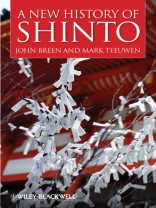This accessible guide to the development of Japan’s
indigenous religion from ancient times to the present day offers an
illuminating introduction to the myths, sites and rituals of kami
worship, and their role in Shinto’s enduring religious
identity.
* Offers a unique new approach to Shinto history that combines
critical analysis with original research
* Examines key evolutionary moments in the long history of
Shinto, including the Meiji Revolution of 1868, and provides the
first critical history in English or Japanese of the Hie
shrine, one of the most important in all Japan
* Traces the development of various shrines, myths, and rituals
through history as uniquely diverse phenomena, exploring how and
when they merged into the modern notion of Shinto that exists in
Japan today
* Challenges the historic stereotype of Shinto as the unchanging,
all-defining core of Japanese culture
Mục lục
List of Illustrations vi
Conventions and Abbreviations Used in the Text vii
Prologue ix
1 An Alternative Approach to the History of Shinto 1
2 Kami Shrines, Myths, and Rituals in Premodern Times 24
3 The History of a Shrine: Hie 66
4 The History of a Myth: The Sun-Goddess and the Rock-Cave 129
5 The Daijosai: A ‘Shinto’ Rite of Imperial Accession 168
6 Issues in Contemporary Shinto 199
Conclusion 221
Notes 229
References 242
Index 253
Giới thiệu về tác giả
John Breen is Reader in Japanese at SOAS (University of
London) and Associate Professor at the International Research
Centre for Japanese Studies in Kyoto, where he edits the
journal Japan Review. His publications include Yasukuni,
the War Dead and the Struggle for Japan’s Past (edited,
2008), Inoue Nobutaka, Shinto: A Short History
(translated and adapted with Mark Teeuwen, 2002), Shinto in
History: Ways of the Kami (edited with Mark Teeuwen, 2000), and
Japan and Christianity: Impacts and Responses, (edited with
Mark Williams, 1996).
Mark Teeuwen is Professor of Japanese Studies at the
University of Oslo. As well as the books authored and edited with
John Breen, he is co-editor of Buddhas and Kami in Japan: Honji
Suijaku as a Combinatory Paradigm (with Fabio Rambelli, 2003)
and The Culture of Secrecy in Japanese Religion (with
Bernhard Scheid, 2006).







![Bìa của Brian Schrag & Julisa Rowe: Community Arts for God's Purposes [Chinese] 貼近神心意的社群藝術 Bìa của Brian Schrag & Julisa Rowe: Community Arts for God's Purposes [Chinese] 貼近神心意的社群藝術](https://static.worldofdigitals.com/thumb_webp/740/9781645083740.webp)




